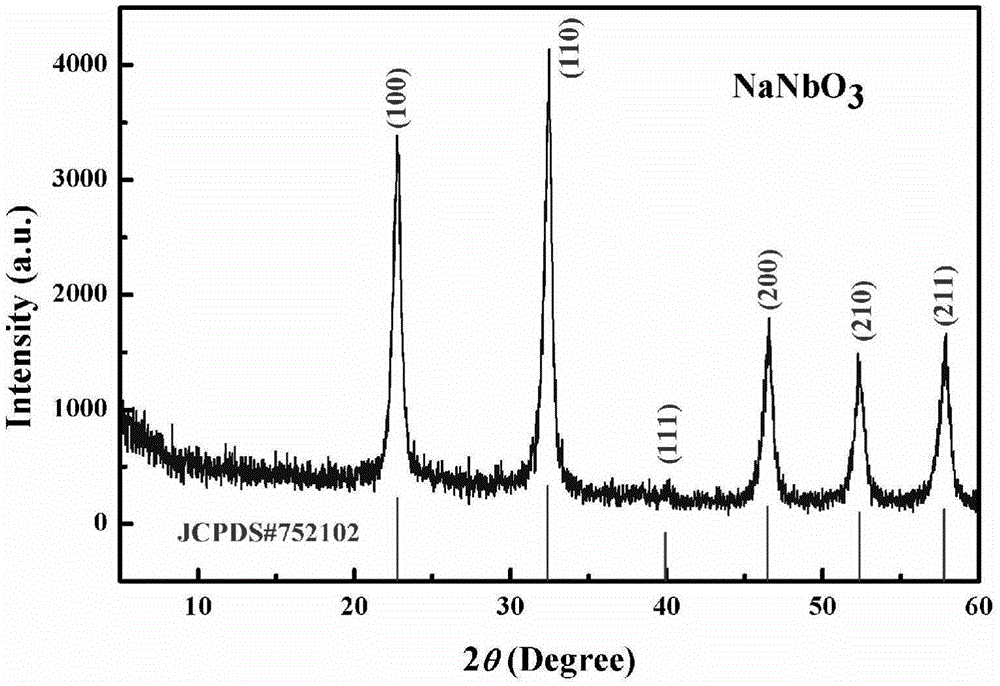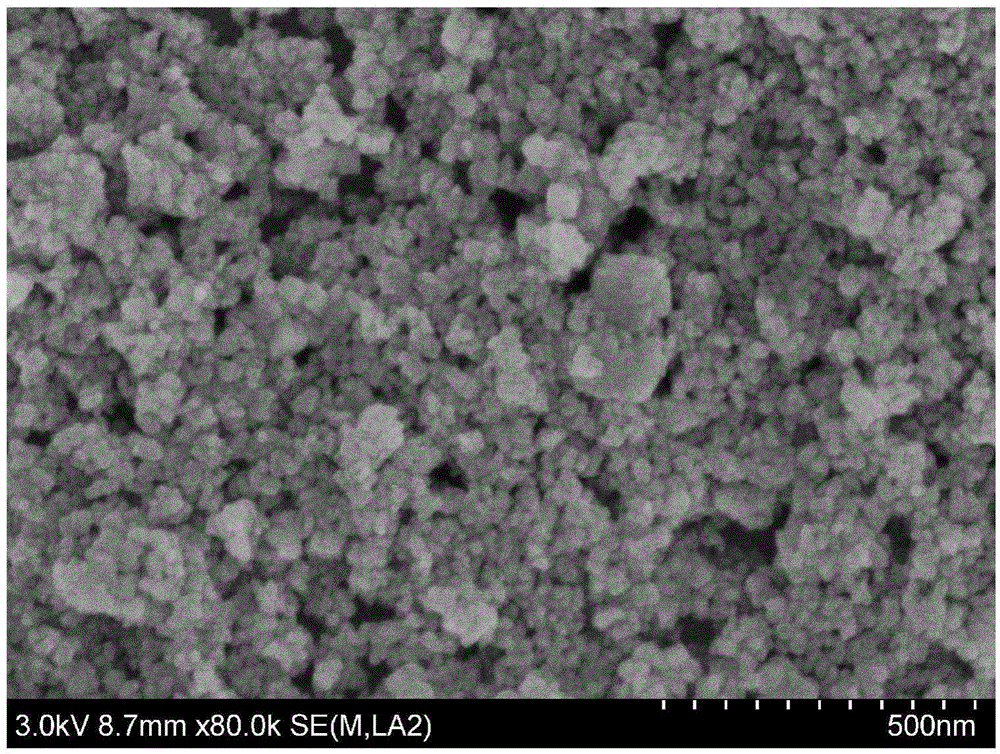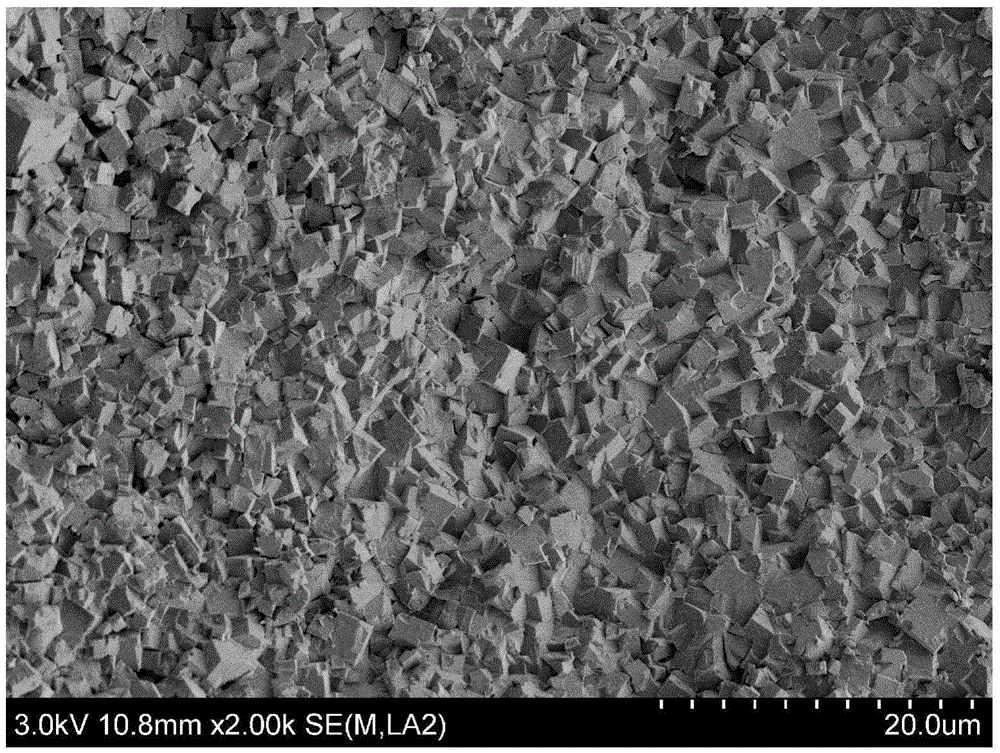Preparation method of high-performance sodium niobate dielectric ceramic powder
A technology of dielectric ceramics and sodium niobate, which is applied in the field of inorganic non-metallic functional materials, can solve the problem of inability to obtain high-quality sodium niobate-based functional ceramic powders, poor size and composition uniformity of sodium niobate nanopowders, and inability to It satisfies the problems of ceramic densification and achieves the effects of large-scale production, room temperature dielectric constant enhancement, good stability and repeatability
- Summary
- Abstract
- Description
- Claims
- Application Information
AI Technical Summary
Problems solved by technology
Method used
Image
Examples
Embodiment 1
[0029] Step 1: Add solid sodium hydroxide into 40ml of ethylene glycol according to the concentration ratio of 1.0mol / L, heat and stir, and obtain a reaction solution after it is uniformly mixed with an organic solvent;
[0030] Step 2: Add 0.5 g of niobium pentoxide to the reaction solution obtained in step 1, heat and stir for 30 minutes to form a milky white mixed solution;
[0031] Step 3: Transfer the mixed solution obtained in step 2 to a polytetrafluoroethylene liner with a volume of 60ml, then place the liner in a stainless steel hydrothermal reaction kettle and seal it, and carry out a 6h heat preservation reaction at 180°C. After the reaction is completed, Cool naturally to room temperature to obtain white precipitate;
[0032] Step 4: Using deionized water and absolute ethanol to wash and centrifuge the white precipitated product multiple times respectively, the rotation speed is 3000rpm, and the time is 30min, and all residual ions and organic solvents are washed a...
Embodiment 2
[0037]Step 1: Add solid sodium hydroxide into 40ml of ethylene glycol according to the concentration ratio of 1.0mol / L, heat and stir, and obtain a reaction solution after it is uniformly mixed with an organic solvent;
[0038] Step 2: Add 0.5 g of niobium pentoxide to the reaction solution obtained in step 1, heat and stir for 30 minutes to form a milky white mixed solution;
[0039] Step 3: Transfer the obtained mixed solution to a polytetrafluoroethylene liner with a volume of 60ml, then place the liner in a stainless steel hydrothermal reaction kettle and seal it, carry out a 4h heat preservation reaction at 220°C, and cool it down naturally after the reaction is completed to room temperature to obtain a white precipitate;
[0040] Step 4: Using deionized water and absolute ethanol to wash and centrifuge the white precipitated product multiple times respectively, the rotation speed is 3000rpm, and the time is 30min, and all residual ions and organic solvents are washed awa...
Embodiment 3
[0045] Step 1: Add solid sodium hydroxide into 40ml of ethylene glycol according to the concentration ratio of 1.0mol / L, heat and stir, and obtain a reaction solution after it is uniformly mixed with an organic solvent;
[0046] Step 2: Add 0.5 g of niobium pentoxide to the mixed solution obtained in Step 1, heat and stir for 30 minutes to form a milky white mixed solution;
[0047] Step 3: Transfer the obtained mixed solution to a polytetrafluoroethylene liner with a volume of 60ml, then place the liner in a stainless steel hydrothermal reaction kettle and seal it, carry out a 6h heat preservation reaction at 220°C, and cool naturally after the reaction is completed to room temperature to obtain a white precipitate;
[0048] Step 4: Using deionized water and absolute ethanol to wash and centrifuge the white precipitated product multiple times respectively, the rotation speed is 3000rpm, and the time is 30min, and all residual ions and organic solvents are washed away;
[004...
PUM
| Property | Measurement | Unit |
|---|---|---|
| Average grain size | aaaaa | aaaaa |
Abstract
Description
Claims
Application Information
 Login to View More
Login to View More - Generate Ideas
- Intellectual Property
- Life Sciences
- Materials
- Tech Scout
- Unparalleled Data Quality
- Higher Quality Content
- 60% Fewer Hallucinations
Browse by: Latest US Patents, China's latest patents, Technical Efficacy Thesaurus, Application Domain, Technology Topic, Popular Technical Reports.
© 2025 PatSnap. All rights reserved.Legal|Privacy policy|Modern Slavery Act Transparency Statement|Sitemap|About US| Contact US: help@patsnap.com



